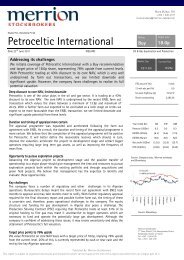Quarterly Bulletin Q3 2013
Quarterly Bulletin Q3 2013
Quarterly Bulletin Q3 2013
You also want an ePaper? Increase the reach of your titles
YUMPU automatically turns print PDFs into web optimized ePapers that Google loves.
Developments in the International<br />
and Euro Area Economy<br />
<strong>Quarterly</strong> <strong>Bulletin</strong> 03 / July 13<br />
57<br />
Economic Growth – Outlook<br />
Euro area GDP may begin to pick up modestly<br />
in the second half of the year, as improvements<br />
in the net trade position outweigh weak<br />
domestic demand. Euro area GDP is likely<br />
to be supported by positive developments in<br />
Germany, where the growth recorded in Q1 is<br />
expected to be sustained throughout <strong>2013</strong>.<br />
Domestic demand is expected to continue<br />
to exert a significant drag on euro area GDP<br />
growth for the rest of <strong>2013</strong>. Private investment<br />
in particular will continue to contract across<br />
the euro area as business expectations<br />
and industrial confidence levels remain low.<br />
Some improvement is anticipated in 2014<br />
as export demand stimulates machinery<br />
and equipment investment and sentiment<br />
improves. Consumption is expected to remain<br />
muted during <strong>2013</strong> as weak labour markets,<br />
combined with low levels of confidence<br />
and on-going balance sheet adjustment in<br />
several countries, could serve to negatively<br />
impact household spending capacity. These<br />
factors are expected to wane only gradually,<br />
maintaining a drag in some countries into<br />
2014. This might be partly offset by increases<br />
in real incomes arising from falling inflation.<br />
Government consumption is expected to<br />
be fairly flat over <strong>2013</strong>, reflecting on-going<br />
fiscal consolidation efforts across the euro<br />
area, before picking up modestly in 2014.<br />
Imports are expected to remain weak in<br />
response to dampened domestic demand,<br />
although some pick-up is likely in response to<br />
increased activity in exports with high import<br />
content. The net trade position is expected<br />
to be the primary driver of any GDP growth<br />
during <strong>2013</strong> and could serve to offset weak<br />
domestic demand. Thereafter, while exports<br />
are expected to gain momentum during 2014,<br />
import demand is also expected to pick up<br />
in response to improved domestic demand<br />
conditions.<br />
The OECD revised down their forecasts for<br />
euro area GDP growth for <strong>2013</strong> and 2014 to<br />
-0.6 and 1.1 per cent, respectively, with the<br />
expectation that external demand will drive<br />
GDP growth and the headwinds weighing on<br />
domestic demand will abate only gradually<br />
(Table 1). These forecasts are in line with the<br />
June Eurosystem Broad Macroeconomic<br />
Projections Exercise projections for euro area<br />
GDP growth in both years. While adverse<br />
risks attached to the forecasts have abated<br />
somewhat over the past year, they are still<br />
judged to be on the downside. Renewed<br />
uncertainty within the euro area may<br />
undermine the potential for consumption and<br />
investment to regain some ground toward the<br />
end of <strong>2013</strong> and into 2014. In addition, ongoing<br />
balance sheet correction in the private<br />
sector and persistently low levels of confidence<br />
arising from high unemployment may continue<br />
to weigh on any recovery.<br />
Inflation – Recent Developments<br />
Euro area annual HICP inflation has been<br />
trending downwards since August 2012,<br />
reaching a three year low of 1.2 per cent in<br />
April. While recent lower inflation rates primarily<br />
reflect a reduced contribution from energy<br />
prices, the April figure was artificially low due<br />
to a distortion related to the timing of Easter<br />
this year relative to last. Inflation increased<br />
to 1.4 per cent in May as these distortions<br />
unwound. Core inflation, meanwhile, has<br />
remained relatively steady for some time. Any<br />
downward price pressures emanating from<br />
increased economic slack have largely been<br />
offset by increased contributions from both<br />
administered prices and indirect taxes in the<br />
two components that make up core inflation,<br />
namely services and non-energy industrial<br />
goods. Nevertheless, a slight downward<br />
trend in the core rate is discernible, as HICP<br />
excluding food and energy averaged 1.3<br />
per cent in the six months up to May <strong>2013</strong>,<br />
down from an average of 1.5 per cent in the<br />
preceding six-month period.<br />
Since peaking in early 2011 at 6.6 per cent,<br />
producer price inflation (excluding construction)<br />
has generally been on a downward trajectory,<br />
falling to -0.2 per cent in May <strong>2013</strong>. PMI<br />
survey measures of prices, meanwhile, indicate<br />
weak price pressures in the manufacturing<br />
sector. The manufacturing input price index




